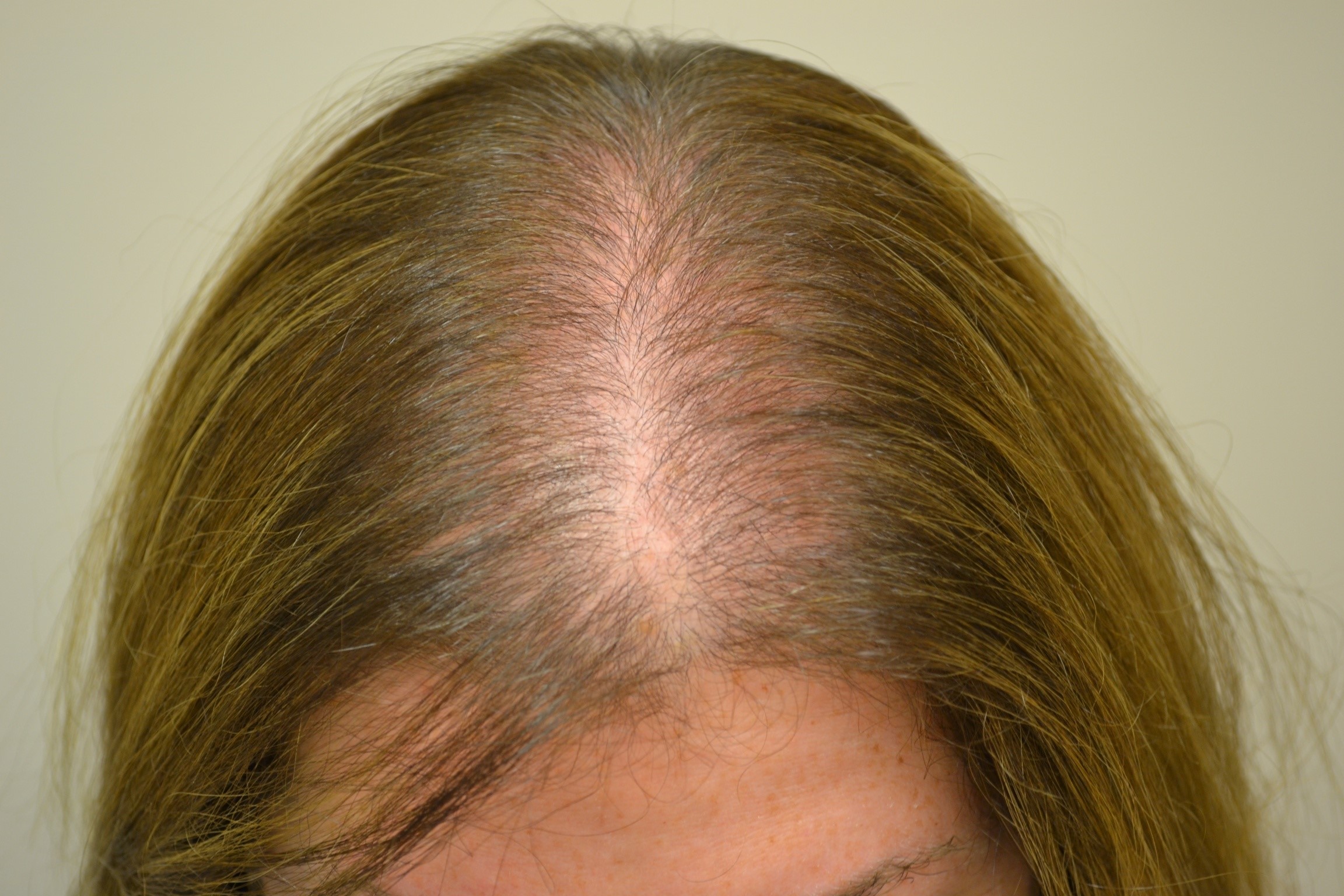Hair loss or alopecia, is a very common presenting symptom and there are a range of conditions that can cause it. Hair loss is categorized into two broad categories: scarring, which leads to permanent destruction of the hair follicle, and nonscarring, in which the hair follicles remain intact. The vast majority of hair loss is nonscarring and includes such conditions as pattern baldness, telogen effluvium and alopecia areata. Scarring alopecia is less common and includes such conditions as discoid lupus, lichen planopilaris, folliculitis decalvans, traction alopecia and central centrifugal cicatricial alopecia. Overall, the majority of hair loss in both men and women is pattern baldness, also referred to as androgenetic alopecia. Both genetic and hormonal factors play a role in pattern baldness. Another common cause of hair loss is telogen effluvium or excessive hair shedding. A thorough patient evaluation is important in order to identify potential triggers of telogen hair shedding. Common triggers for telogen hair shedding include a major illness, surgery, parturition, rapid weight loss, nutritional deficiency, thyroid dysfunction, stress and certain medications.
Specific factors that can cause hair loss:
- Medications, vitamins, or minerals: medications used to treat high blood pressure, heart problems, depression or gout; chemotherapy or radiation treatment for cancer patients; and in some cases, unusually high levels of vitamin A or low levels of iron or protein. For women, birth control pills can cause hair loss.
- Illness, including thyroid disease and severe infection.
- Scalp conditions, including psoriasis, seborrheic dermatitis, tinea capitis and folliculitis.
- Trauma, including traction alopecia resulting from certain hair styles that cause trauma to the hair follicles and trichotillomania resulting from repetitive pulling and breaking of one’s own hair.
What are the treatment options for hair loss?
Therapies for hair loss include identifying and treating underlying cause, topical minoxidil, antiandrogen medication and hair transplantation in selected patients.
Minoxidil (Rogaine) is FDA-approved for treating male and female pattern baldness. Minoxidil is a topical solution that is applied by directly rubbing it onto the scalp where hair growth is desired. It is available over-the-counter and does not require prescription.
Finasteride is FDA-approved to treat male pattern baldness. Finasteride is not approved for female pattern baldness. Like all prescription products, Finasteride should be given under a physician’s care.
Permanent hair loss can also be treated by hair transplantation or hair replacement surgery. Hair replacement surgery is a cosmetic procedure and includes such replacement procedures as micro-grafting, slit grafting, punch grafting, and scalp reduction. The type of hair loss as well as the patient’s circumstances and desires determine which hair replacement procedures are most suitable.
Who is a candidate for hair replacement?
- Men with male-pattern baldness.
- Some women with thinning hair.
- A person who has lost some but not all hair as a result of burns or other scalp injuries.
Who is not a candidate for hair replacement?
Hair replacement is not recommended for the following patients:
- Women with a diffuse, or wide-spread, pattern of hair loss
- Those who do not have sufficient “donor” sites (hair-bearing portions of the head from which hair-bearing skin is taken)
- People who form keloid scars or thick fibrous tissue that can result from trauma, burning, or radiation injury
- Those whose hair loss is due to medication.
Common hair replacement procedures
Grafting: Grafting is an outpatient procedure performed in the dermatologic surgeon’s office. Micro-grafts contain only one to two hairs per graft, while slit grafts contain between four and 10, and punch grafts hold 10 to 15 hairs. A local anesthetic is injected into the scalp and sedation is available, if needed, for relaxation and comfort.
What happens during and after the procedure?
The dermatologic surgeon first removes a disc-shaped portion of the hair-bearing scalp from the back of the head. Then, the surgeon cuts the removed scalp into small segments with varying amounts of hair in each graft to achieve a very subtle thickening and “natural” look with this technique.
With each session, 100 to 1,000 hair-bearing segments are transplanted. “Donor” sites are closed with stitches, which usually are then concealed by the surrounding hair. After the grafting session is complete, the scalp is cleaned and covered with gauze and, if necessary, a bandage. Stitches will be removed approximately 10 days later.
How long does the procedure take?
Three to four sessions may be needed to achieve satisfactory “fullness.” After each session, a healing process of two to four months is usually recommended prior to the next procedure.
Are there any side effects?
Most side effects that come with a hair transplant usually go away within one to three weeks. Among the most common side effects are:
- Swelling
- Bruising around the eyes
- Crust may form on the “donor” and “recipient” sites of the scalp
- A lack of feeling or decreased sensation around the “donor” and “recipient” sites of the scalp
- Itching in the “donor” site
Scalp reduction: A scalp reduction is the removal of non-hair-bearing skin from the scalp so that the remaining hair-bearing skin can be stretched to fill in the bald area of the head. Scalp reduction can reduce as much as half of the bald area. It is a procedure performed to cover bald areas on the top and back of the head and is not found to be beneficial for the frontal hairline.
How is this procedure done?
The scalp is injected with local anesthetic and a bald segment of scalp is removed. The surrounding skin is then loosened and gently stretched so that the sections of hair-bearing scalp are brought together and closed with stitches. This procedure may also be performed during punch grafting sessions.
What are the side effects?
- Headache
- Scalp tightness (temporary)
- Swelling (temporary)
- Scarring at the suture lines


No responses yet